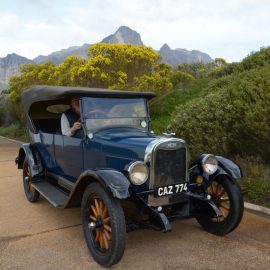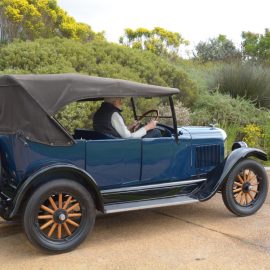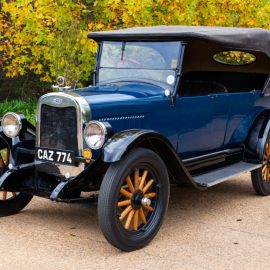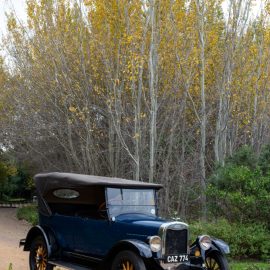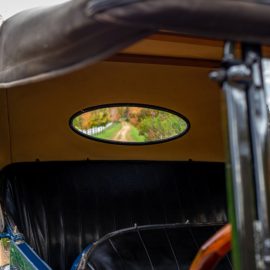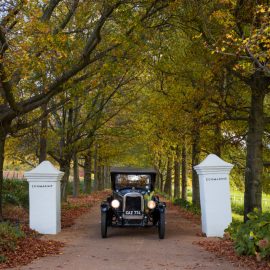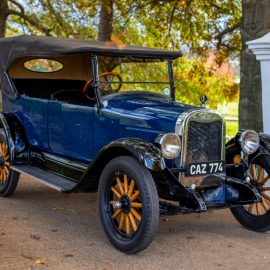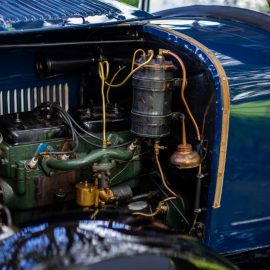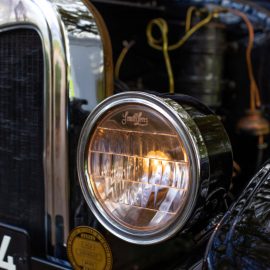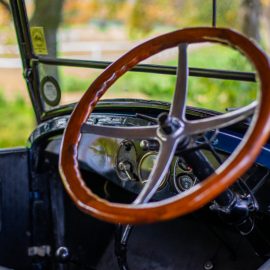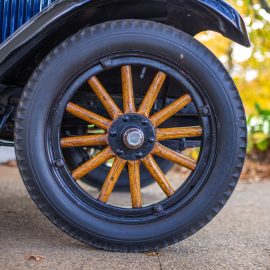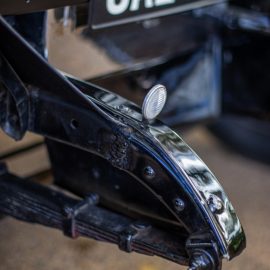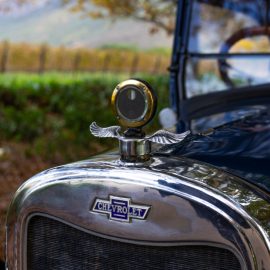
01 Sep Collection In Action: Chevrolet Superior Tourer
In 1925, John Rupert, grandfather of FMM’s patron Johann, replaced his Model T Ford in favour of a new Chevrolet Superior Tourer. Although sold and passed through a number of owners, the car eventually found its way back into the Rupert family, and is still in superb condition and regularly put on display. Mike Monk takes a brief look back at the founding of Chevrolet, and finds a break in the Cape winter rain to drive the car…
William Crapo Durant was born in 1861 to a wealthy Massachusetts family of French descent in Boston, Massachusetts, and in 1886 partnered with Josiah Dallas Dort and founded Flint Road Cart Company, By 1890, the Durant-Dort Carriage Company, based in Flint, Michigan, had become a leading manufacturer of horse-drawn vehicles and by the start of the 20th century, was the largest in the US. Durant soon became a millionaire and on 1 November 1904, Durant assumed control of the troubled Buick Motor Company and used the financial and manufacturing resources of Durant-Dort to correct Buick’s course. Under his guidance, the company was able to become the best-selling automobile in America, outperforming earlier leaders Ford Motor Company, Cadillac, and Oldsmobile, despite having no manufacturing line and only a few extant cars. Then Durant signed a 15-year contract to build Buick power trains at cost-plus pricing with Samuel McLaughlin, the largest carriage manufacturer in Canada.
On September 16, 1908, Durant and McLaughlin opened an escrow account, with which they founded General Motors Holding Company, and acquisition of a number of other manufacturers began. But Durant became financially overextended and banking interests assumed control, forcing him out of GM Holding in 1910. Undeterred, Durant immediately set out to create “another GM”, starting with the Little car, named after its founder, William H Little, but this was a failure. Instead, in 1910, after obtaining a loan of $52 935,25 (co-signed by McLaughlin), he went into partnership with Louis Chevrolet in 3 November 1911, starting the Chevrolet Motor Car Company.
However, in 1914 a disagreement with Louis resulted in Durant buying out his partner and he became president in 1916. The wily Durant used the Chevrolet company to acquire a controlling stake in General Motors with a reverse merger occurring in 1918, and propelled himself back to the GM presidency. In his place as GM Chief Executive, in 1919 Alfred Sloan, with his maxim “a car for every purse and purpose”, chose the Chevrolet brand to become the volume leader in the GM family, selling mainstream vehicles to compete with the likes of Henry Ford‘s Model T. In 1923 a one-model policy was adopted for Chevrolet, with the previous four-cylinder FA and FB and a V8 replaced by the Superior. By 1925 the Chevrolet’s design was up-to-date, with a lot of convenience features the Ford Model T did not have. The selling price was significantly higher than that of the Ford, but by providing financing for instalment buying, as opposed to Ford’s policy of selling cars for cash, Chevrolet sales crept upwards while sales of the Model T started to drop.
The 1923 Superior – dubbed Model B – incorporated a number of changes over the outgoing models and the design was carried over pretty much unchanged for the 1924 model year, although the car was now tagged Model F. However, new body styles were introduced – all bodies were produced by Fisher Body – among them a two-door coach and a four-passenger coupé. A curved front axle and cable-operated brakes were replaced with a straight axle and rod-operated bakes.
Introduced in January 1925, the now Series F Superior had a new radiator design where the upper part of the nickel-plated shell curved down at the centre. Vertical ventilating windscreens were introduced on closed models. A ‘Cadet-style” visor was another new feature. While hickory wood-spoke wheels were standard for all to start with, saloons and coupés soon adopted pressed steel disc wheels – open cars had 30-inch wheels, closed cars 29-inch. Bumpers were an option along with exterior rear-view mirrors, passenger compartment heater and a clock. Cars built from August 1 had a walnut-like steering wheel rim and a new Klaxon horn.
Mechanically, the engine boasted a new block, crankshaft and con-rods as well as a new single-plate dry disc clutch. All Superiors were powered by a cast-iron 171-inch (2 802 cc) overhead-valve four-cylinder engine that delivered 26 hp (19,4 kW) at 2 000 r/min. The sliding three-speed non-synchro gearbox has floor-mounted controls with drive going to a semi-floating rear axle with a 3,82:1 ratio. Rear-wheel brakes are of the external contracting type.
This particular 1925 Chevrolet Superior Tourer originally belonged to John Rupert, a lawyer in Graaff Reinet. Its original base selling price was $525 but a number of options were fitted including a rear bumper, step plates and a spare wheel. It was later sold and passed through a number of owners before a year after John’s son Dr Anton opened the Heidelberg Transport Museum in 1974, Jan Smit, the head of public relations at Rembrandt Tobacco, told Dr Anton that he had been contacted by a Bryan Powell of Sandton, who claimed he was the owner of the car, and wished to sell it. At that time the Chev was thought to be a 1924 model, but after many months of research, including the original registration number plate, it was conclusively proven that the Chev was, in fact, the Rupert car. The final proof was the scars of accident damage on the right-front dumb-iron, which is still visible today. The car’s wood-rim steering wheel and Klaxon horn mean it was built after 1 August 1925. With the car’s provenance verified, the car was purchased for the Heidelberg Museum.
The Chev underwent a restoration in 1996 and registered CAZ 774 before being sold to British American Tobacco in 1999. Dr Anton’s son Johann then purchased the car when the Heidelberg Museum was closed and the collection relocated to form the basis of the Franschhoek Motor Museum.
The doors are small and stepping into the driver’s seat takes a bit of wriggling, especially if the folding hood is erect – and you happen to be taller than average… But once aboard, it is surprisingly comfortable, although the supposed three-passenger rear bench seat would be cramped for a trio of adults. But the Chev immediately feels at home and depressing the floor-mounted starter button brings the big four-cylinder into life. Once up to temperature, the motor runs smoothly and the long, floor-mounted gearshift snicks into place easily. Pedal layout has the button-style accelerator in the middle, and there is enough space between the clutch and brake pedals to give access to most adult-sized footwear, which is not always the case. The angle of the brake and clutch pedals are also ankle friendly, another factor not always a given with cars of this age.
First gear is low, and although I could not find the engine’s torque figure I did find a period graph that suggested a peak output of around 135 N.m. The engine certainly is strong and second gear is remarkably flexible. But once the road ahead opens up and top gear is selected, the Chev really gets into its stride. Transmission noise drops noticeably, and the car’s Tourer title becomes evident. The ride does not jar and the steering effort is not overly heavy, helped in no small way by the superb-to-hold wheel. As to be expected with a car of this age, braking needs care and forward thinking, but is not an onerous task.
Some veteran and vintage cars are a real challenge to drive, while for no obvious reason, getting behind the wheel of others simply feels good from the get-go. This 96-year-old Chev is just such a car, making passengers feel at home and putting a smile on faces. Little wonder, then, that the Superior was a sales success. In 1927 Chevrolet outsold Ford for the first time, although Ford had halted its production for a while to facilitate the changeover from the Model T to the Model A. Incidentally, the 103-inch (2 616 mm) Chevrolet chassis was shared with other GM products at the time including Buick, Cadillac GMC, Oakland and Oldsmobile.
Superior in name, accomplished in execution.




